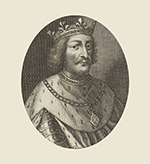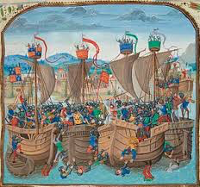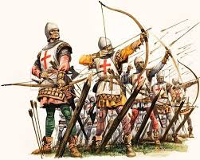The French King Philip VI
Philip VI was King of France in the 14th Century. The first of the Valois Kings of France, he was on the throne at the start of the Hundred Years War. 
His father was Charles of Valois, who had served as a primary advisor to the three previous Kings of France, Louis X, Philip V, Charles IV. When Charles, the last Capetian king, died, in 1328, Philip of Valois became regent. Charles IV had died without a male heir, but his wife, Joan of Evreux, was pregnant when her husband died. Joan's child, born on April 1, was a girl, Blanche. Following the precedent set out by Philip V, the French nobles rejected the descendant of the king because she was female and instead crowned Philip of Valois as King Philip VI on May 29. One of Philip's early successes was in Flanders, where, at the Battle of Cassel, he and his army restored Louis I, Count of Flanders, to power. Also at this time, Philip and England's King Edward III enjoyed good relations. Edward supported Philip's claim to the throne, and the two monarchs discussed for a time a joint military exercise. After a few years, however, Edward claimed the French throne, by virtue of his being the son of Isabella, whose father was King Philip IV. England was still in control of the Duchy of Gascony at this time, and one of duties that the English ruler was supposed to perform was to pay homage to the French king. Edward's father, Edward II, had been reluctant to so declare, and that had caused tension between England and France in some of the preceding years. At the same time, France and Scotland had relatively recently cemented a mutual defense pact known as the Auld Alliance, and French monarchs had become involved at times in political intrigue in both England and Scotland. The latest example of this was a dispute over the Scottish throne, in the wake of the death of the famous Robert the Bruce. His son had succeeded him as King David II, and Philip VI had supported this succession. England's Edward III, however, wanted on the throne Edward Balliol, the son of the unfortunate John Balliol. Edward III set about making friends of France's neighbors, including Brittany and Flanders, the latter of which had a recent history of rebelling against French kings. Edward also enjoyed the support of Robert of Artois, who had initially supported Philip's claim to the throne but switched sides after the king stopped him from acquiring an inheritance by devious means. In 1337, the Hundred Years War began. It would consume a succession of monarchs and men well into the next century. Philip VI invaded Guienne, which was part of Aquitaine, the large area of France that had been property of English monarchs since King Henry II had married Eleanor of Aquitaine in 1152. Edward responded with military action of his own. 
Edward quickly made an important ally in Louis the Bavarian, gaining much-needed money and supplies and a base from which to invade France from the northeast. English forces won the naval Battle of Sluys in 1340 and gained control of the English Channel. Edward officially declared himself King of France in that year as well. 
England had some early successes, wielding the longbow to devastating effect at the Battle of Crécy, in 1346. In 1347, English forces won a long siege at Calais and seized that important port city. The Black Death devastated Europe in 1348 and hit France especially hard. Philip faced increasingly bleak prospects for raising money to keep the war going. In the midst of these titanic struggles, he died, on Aug. 22, 1350, at Coulombes Abbey. He had married Joan of Burgundy in July 1313. They had nine children, including an eldest son, who became King John II. Joan had died in 1349, and Philip had married Blanhce of Navarre the following year; they had a daughter.
|
|
Social Studies for Kids
copyright 2002–2026
David White




